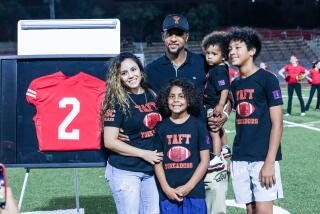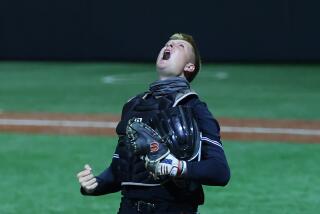Program Brings Baseball Back to Inner City
- Share via
John Young grew up in South Central Los Angeles at a time when youth baseball flourished in the inner city and youngsters such as Bob Watson, Bobby Tolan and Willie Crawford traveled from sandlot to sandlot perfecting their skills.
“There were thousands of leagues,” said Young, 41. “You’d play on two or three teams.”
Eddie Murray, Ozzie Smith, Darryl Strawberry and Eric Davis all came through that same inner-city pipeline, which began drying up a few years ago as inner-city programs fell apart amid economic and organizational problems.
The idea of youths having no place to play baseball saddened Young.
And, fortunately for the old neighborhood, it finally spurred him into action.
“I grew up in the area, so I feel I have a stake here,” said Young, a scout for the Texas Rangers who attended Mt. Carmel High at 71st and Hoover streets, and went on to play at Chapman College and in the Detroit Tiger organization. Mt. Carmel has since closed.
Last year, Young and the Professional Baseball Scouts of Southern California launched a program that has brought baseball back to South Central Los Angeles. Reviving Baseball in Inner Cities (RBI) provides youths with a free opportunity to improve their baseball skills and their futures.
“We want to use baseball as a carrot to expose kids to other avenues that can help them in their lives,” Young said. “My personal goal is to use all my resources in baseball to show these kids that, ‘Hey, we can have a great baseball program in the city.’ ”
Fueled by a $50,000 grant from major league baseball and support from the Dodgers and Angels, the RBI program kicked off last year with 180 youths competing on 12 teams in a league for 13- and 14-year-olds at Harvard and Sutton parks. Jeff Shimizu, former Venice High baseball coach now at Santa Monica College, designed a class to train coaches and provided the program with six student counselors from the college.
This year, the Amateur Athletic Foundation provided RBI with $78,000, allowing the program to add a 15- and 16-year-old division and expand to Rancho Cienega Park. About 600 youths are participating in leagues that compete from May to August.
Strawberry, Murray, Hubie Brooks and Tony Gwynn other major league players have spoken to youths in the program, as have former youth league players who have established careers outside sports.
“We like the ballplayers to come out and talk to them, but what we really want them to see are the people who might have played sports and are now successful in the real world,” said Young, who lives in Diamond Bar. “As the program progressed, we saw this happening. Kids were saying, ‘Well, I may not be able to hit 40 home runs, but I can go to school and be a doctor, a lawyer, an electrician or whatever.’ ”
Young said he had the idea for RBI 15 years ago when he was scouting the South for the Detroit Tigers after finishing his playing career with the club. During his travels, Young bounced his ideas for RBI off scouts such as Joe McIlvaine, now vice president of the New York Mets, and Larry Doughty, the general manager for the Pittsburgh Pirates.
Nothing came of the discussions, Young said, “until all of a sudden, 10 years had passed and I’m talking about it with a different group of guys.”
Young did a survey of the 1986 draft and found that 81% of the players who signed professional contracts were from four-year colleges. He then surveyed the rosters of four-year schools from San Diego to Fresno and found that fewer than 4% of the players were black and fewer than 3% were Hispanic.
Young told Roland Hemond, general manager of the Baltimore Orioles, about his findings and his idea for RBI. Hemond suggested contacting then-Commissioner Peter Ueberroth, who granted the program its initial funding.
In August, RBI will hold its championship games at Dodger Stadium. After the season, 60 youths will be selected for an Academy of Excellence that will feature Saturday workouts with scouts and players, and meetings with academic counselors and professionals.
“The perception is that to have a good program, you have to go to the suburbs,” Young said. “But I think we’re showing people that it can be done right here if you get people who care involved.”
More to Read
Go beyond the scoreboard
Get the latest on L.A.'s teams in the daily Sports Report newsletter.
You may occasionally receive promotional content from the Los Angeles Times.











